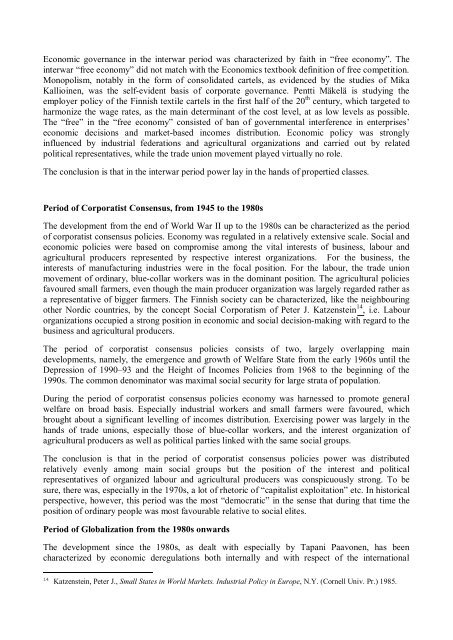Suomen Akatemia VALTA-OHJELMAN HANKKEIDEN TULOKSET
Suomen Akatemia VALTA-OHJELMAN HANKKEIDEN TULOKSET
Suomen Akatemia VALTA-OHJELMAN HANKKEIDEN TULOKSET
You also want an ePaper? Increase the reach of your titles
YUMPU automatically turns print PDFs into web optimized ePapers that Google loves.
Economic governance in the interwar period was characterized by faith in “free economy”. The<br />
interwar “free economy” did not match with the Economics textbook definition of free competition.<br />
Monopolism, notably in the form of consolidated cartels, as evidenced by the studies of Mika<br />
Kallioinen, was the self-evident basis of corporate governance. Pentti Mäkelä is studying the<br />
employer policy of the Finnish textile cartels in the first half of the 20 th century, which targeted to<br />
harmonize the wage rates, as the main determinant of the cost level, at as low levels as possible.<br />
The “free” in the “free economy” consisted of ban of governmental interference in enterprises’<br />
economic decisions and market-based incomes distribution. Economic policy was strongly<br />
influenced by industrial federations and agricultural organizations and carried out by related<br />
political representatives, while the trade union movement played virtually no role.<br />
The conclusion is that in the interwar period power lay in the hands of propertied classes.<br />
Period of Corporatist Consensus, from 1945 to the 1980s<br />
The development from the end of World War II up to the 1980s can be characterized as the period<br />
of corporatist consensus policies. Economy was regulated in a relatively extensive scale. Social and<br />
economic policies were based on compromise among the vital interests of business, labour and<br />
agricultural producers represented by respective interest organizations. For the business, the<br />
interests of manufacturing industries were in the focal position. For the labour, the trade union<br />
movement of ordinary, blue-collar workers was in the dominant position. The agricultural policies<br />
favoured small farmers, even though the main producer organization was largely regarded rather as<br />
a representative of bigger farmers. The Finnish society can be characterized, like the neighbouring<br />
other Nordic countries, by the concept Social Corporatism of Peter J. Katzenstein 14 , i.e. Labour<br />
organizations occupied a strong position in economic and social decision-making with regard to the<br />
business and agricultural producers.<br />
The period of corporatist consensus policies consists of two, largely overlapping main<br />
developments, namely, the emergence and growth of Welfare State from the early 1960s until the<br />
Depression of 1990–93 and the Height of Incomes Policies from 1968 to the beginning of the<br />
1990s. The common denominator was maximal social security for large strata of population.<br />
During the period of corporatist consensus policies economy was harnessed to promote general<br />
welfare on broad basis. Especially industrial workers and small farmers were favoured, which<br />
brought about a significant levelling of incomes distribution. Exercising power was largely in the<br />
hands of trade unions, especially those of blue-collar workers, and the interest organization of<br />
agricultural producers as well as political parties linked with the same social groups.<br />
The conclusion is that in the period of corporatist consensus policies power was distributed<br />
relatively evenly among main social groups but the position of the interest and political<br />
representatives of organized labour and agricultural producers was conspicuously strong. To be<br />
sure, there was, especially in the 1970s, a lot of rhetoric of “capitalist exploitation” etc. In historical<br />
perspective, however, this period was the most “democratic” in the sense that during that time the<br />
position of ordinary people was most favourable relative to social elites.<br />
Period of Globalization from the 1980s onwards<br />
The development since the 1980s, as dealt with especially by Tapani Paavonen, has been<br />
characterized by economic deregulations both internally and with respect of the international<br />
14 Katzenstein, Peter J., Small States in World Markets. Industrial Policy in Europe, N.Y. (Cornell Univ. Pr.) 1985.


